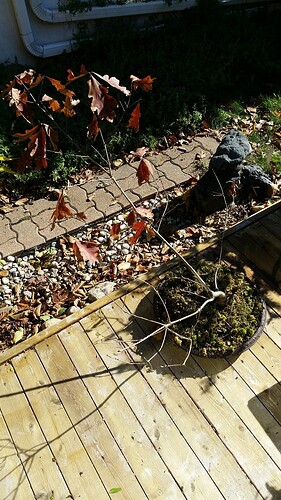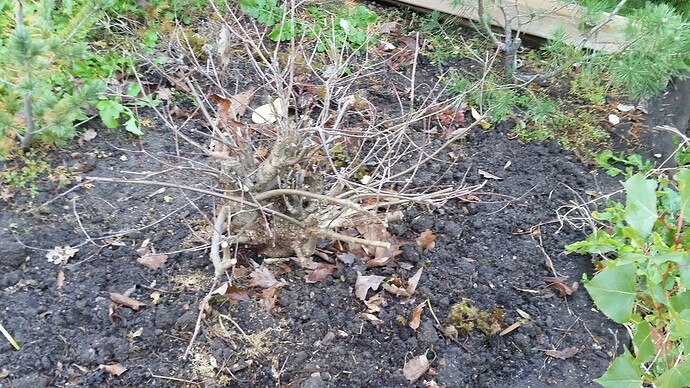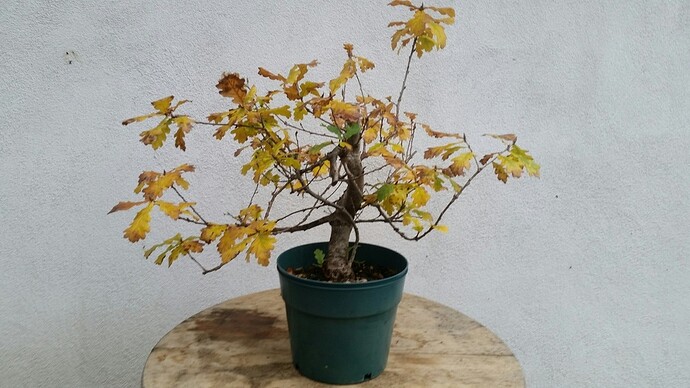Stunted deciduous trees found in the wild seem to be hard to come by given their great water demands. Their need for more water often excludes them from rocky areas where stunted conifers are found. The exception being pasture land where the four legged pruners roam.
Recently, I have come across some stunted and semi stunted white oaks. Not big trees - one inch diameter trunks for shohin. One was collected last fall and is doing well. A second was collected about 3 weeks ago, yes during the heat of the summer, and it is still green and is holding its own…so far. The jury is still deliberating on this one.
So, I am wondering if anyone has any collecting, managing this species as bonsai experience or air laying tips for white oak?
This topic hasn’t really brought the doors down or burned the thread from overheated contributions. So I am going to reply to myself and turn this thread into a source of information.
I was intrigued by an article written by Harry Harrington (UK) “Collecting and Repotting Quercus robur/English or European Oak Bonsai” available from B4me. Harry talked about greater collecting success during the summer rather than spring as is often recommended.
So after discovering some interesting white oaks in Ontario, Canada, I attempted to apply Harry’s technique. I collected three white oaks this summer in July, August and September. July and August are hot and humid months. September is a transition month to fall with hot and cool weather. All three trees appear well. One noticeable feature was that the July tree kept its green leaves the longest. The August tree’s foliage turned into its fall colors (red in this case). The September tree’s leaves went brown.
The conclusion, the July tree got established and started to grow and photosynthize with its green leaves.
The August tree slowed down and went red. The September tree shut down right away going brown. It seems to me that the July tree did the best. I can’t say all of the trees were the same for an accurate comparison. I also have to see which trees survive the coming winter. But one thing I am glad for was that it was a cool day when I collected the September beast.
More to report next spring.
Nice one @DavidJ,
Did they have long tap roots? That appears to be the mains difficulty with European oak.
Great question Andy. For the three oaks I collected this year, the jury is still deliberating as to where they will live through the winter or die. So far, so good. These oaks were collected in rocky granite outcrops/forest/bog mix we call the Canadian shield with stands of white pine, common juniper, larch, spruce, red maple, birch and oaks. They were collected among the rocks. The portion above ground was straight and portion below grade meandered through the rocks and duff like a snake. With side roots above, the tape roots was cut where it disappeared into the bedrock. The trees were planted in fairly shallow pots 2-4". The largest one went into the ground. So essentially, the tap roots went deep but not before producing other secondary roots along the way.
I should mention that I collected a small oak in gravel beside a river last fall. It is growing well with a 2" base and in 4" of potted soil. The field soil was all gravel and I got enough of the upper roots.
Your collecting environment sounds beautiful Dave. It can be frustrating when there isn’t much information on a specific variety, but to a certain extent for western bonsai practitioners, we are all pioneers. When we work with local material it’s often little more than making informed guesses, but that’s all part of the fun.
Pioneers. So true. Sharing our experiences brings us closer to answers and closer as bonsai comrades regardless of region or country. I will try to find a photo that captures the oak collecting area. I am sure that it won’t look like “Kansas”.
I’m late to the party, but this thread can still contribute! This discussion slash/experiment is awesome.
What results did you see as we get ready to leaf out. I see you’re in KS too btw. I’m looking at a few sawtooth oaks (acutissima).
Never too late when it comes to bonsai Emawman, these things take time to come up with answers. BTW, l live in Toronto, Ontario, Canada. The white oaks l collected have not come out of dormancy yet. Oaks are the last deciduous to leaf out. l will follow up with those who made muster in the spring, and who didn’t.
I am in the Pacific N W. I like oaks. I have had limited success with Utah Oak, Q. gambelii.
I prefer small to medium bonsai-- 15". Gambelii leaves are relatively small, and they are reasonably easy to grow, budding back profusely. Unfortunately, the roots go crazy deap, at 6 years in ground the first fine roots were at 24 ". Best to start small (acorn) in a pot and cut roots regularly.
Unfortunately, voles and squirrels like them wsy too much.
These two are going on 20 years… sorry, no leaves yet…just now warming up here.
.
Red, white, English oak leaves wind up too large and out of proportion until the bonsai gets >3 feet tall… I have ten of each in various states of developement. Hope springs eternal…
In the photo of a white oak (quercus alba) above in the 4" pot, in one year l got quite a reduction. The tree hasn’t even ramified yet. We’ll see how things progress with more pix later. l love what you have achieved with your gambelii’s. l have seen some magnificent oaks in the middle of fields north of the Golden Gate bridge in California.
INFO UPDATE: all four quercus alba’s l collected are budding out with leaves to follow. l just repotted the smaller oak l collected in the fall of 2017.
Aug 19, 2019 update. All four oaks are doing well in fact the 1st one l repotted is now being air layered. l don’t know if it will be successful as oaks are known to be difficult layering. And this spring, l successfully collected another alba, the best of the bunch. Hopefully the debut will be worth the wait. So now l have collected oaks in the spring, summer and fall - all successfully.




